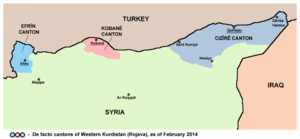Safe Zone (Syria)
Safe Zone, is an area that has been planned by Turkish authorities to create a buffer zone within Syria. The potential zone is planned between Afrin and Kobane cantons.
Background
During the 1990s, safe zones were planned in Iraq and Bosnia in order to protect civilians from Iraqi Army and Yugoslavian Army. No fly zone was planned by US-led coalition in Iraqi Kurdistan and Shia-majority regions of Iraq after the Gulf War. Srebrenica, Žepa, Sarajevo, Goražde and Bihać were incorporated to pro-NATO safe regions after the Operation Deliberate Force in Bosnia. Also, US forces created mini-safe zones for coalition forces within Iraq. Green Zone was established to protect Western officials and coalition soldiers from being jeopardized during Iraqi War.
Turkey and Syrian opposition proposed a safe zone that includes some regions of Northern Syria in 2013, however United States and the other Western governments was not willing to accept these plans.[1][2] After the advancements of ISIL in Iraq, Turkey and United States negotiated 'safe zone', while USA accepted 'ISIL-free zone', US officials were reluctant to accept a no fly zone.[3][4]
After the attacks of ISIL in Syrian Kurdistan, tens of thousands non-Sunnis, Christians and Yazidis fled to Turkey. In the beginning of 2015, refugees has begun to cross Turkish-Greek border and escaped to European countries. These huge refugee flows caused taking a re-consideration to create a safe zone for civilians in Syria.[5] In February 2016, Chancellor of Germany Angela Merkel said, "In the current situation it would be helpful if there could be such an area where none of the parties are allowed to launch aerial attacks – that is to say, a kind of no-fly zone".[6]
Safe Zone negotiations

The safe zone in Syria has not been created because of disagreements between US and Turkish governments yet. The main dissidence is the who will be the initial actor to be eliminated in Syria. Turkey wants al-Assad regime to be gone as soon as possible while US says the war against ISIS in the main objective of US policies in Syria.[7]
The content of the safe zone is another reason of the disagreement between US and Turkish governments. According to Turkey, the safe zone must include no fly zone while US rejects any possibility to establish a no fly zone. Turkey supports the involvement of Syrian opposition forces in the region after ISIS eliminated. However, US is reluctant against Syrian opposition for they include a lot of radical Islamist elements.[8]
Turkish undersecretary Feridun Sinirlioğlu expressed the Turkish opinion about the safe zone in August 2015, saying that Turkish forces will strike not only ISIS force but also Syrian regime and Kurdish YPG forces if they enter into the region.[9] Couple of days later, US officials made a statement that they were not to accept any aggressiveness against YPG.[10] According to Turkey, YPG is considered as a threat because of its strong ties with PKK. On the other hand, US says PKK is a terrorist organisation but YPG is a different actor and one of the main allies of US in the war against ISIS. For US, the exclusion of YPG from safe zone areas may cause to a big gap for the fight against radical factors.[11]
The other debate is about the name of the safe zone. Turkey calls the zone as 'safe zone from ISIS, Syrian regime and YPG'. However, US declared they will only accept 'ISIS-free zone'.[12][12] US has not make any declaration about the possible involvement of Syrian regime to the region.
The zone
At the moment, places between Azaz and al-Rai, Syria like Kafr Kalbin, Kafrah, Sawran, Ihtaymilat, Dabiq, Barih, Kafr Elward, Ghoz, Ghaytun, Akhtarin, Baruza, Tall Tanah, Kaljibrin, Qebbet al-Turkmen, Al-Ghandurah, Arab Hassan Sabghir, Mahsenli, and Halwanji have been included to the safe zone. In addition, Erdoğan said that “They will leave (Manbij). They will to go east of the Euphrates river. If not, we will do what is needed.”[13]
References
- ↑ "Turkey PM 'will support' Syria no-fly zone". Retrieved 31 May 2016.
- ↑ "Syrian opposition calls for no-fly zone". Retrieved 31 May 2016.
- ↑ Tisdall, Simon (27 July 2015). "Syrian safe zone: US relents to Turkish demands after border crisis grows". Retrieved 31 May 2016.
- ↑ "DIPLOMACY - US and Turkey agree to forge 'ISIL-free zone' in Syria, official confirms". Retrieved 31 May 2016.
- ↑ "Solution to refugee crisis is to end Syria's civil war, UN official says". Retrieved 31 May 2016.
- ↑ Wintour, Patrick (16 February 2016). "Turkey revives plan for safe zone in Syria to stem flow of refugees". Retrieved 31 May 2016.
- ↑ http://www.washingtontimes.com, The Washington Times. "U.S. reluctance to arm Syrian rebels may embolden Assad". Retrieved 31 May 2016.
- ↑ "National Security Zone". Retrieved 31 May 2016.
- ↑ "http://www.independent.co.uk/news/world/middle-east/war-with-isis-is-turkeys-buffer-zone-in-syria-a-matter-of-selfdefence--or-just-antikurd-10464443.html". Retrieved 31 May 2016. External link in
|title=(help) - ↑ "http://rudaw.net/turkish/world/110820155". Retrieved 31 May 2016. External link in
|title=(help) - ↑ "Fight against IS helps PKK gain global legitimacy - Al-Monitor: the Pulse of the Middle East". 16 September 2014. Retrieved 31 May 2016.
- 1 2 "U.S. denies reaching agreement with Turkey on Syria 'safe zone'". 11 August 2015. Retrieved 31 May 2016 – via Reuters.
- ↑ Suzan Fraser , Turkish leader threatens more involvement on Syrian border, The Washington Post. October 26 at 3:01 PM